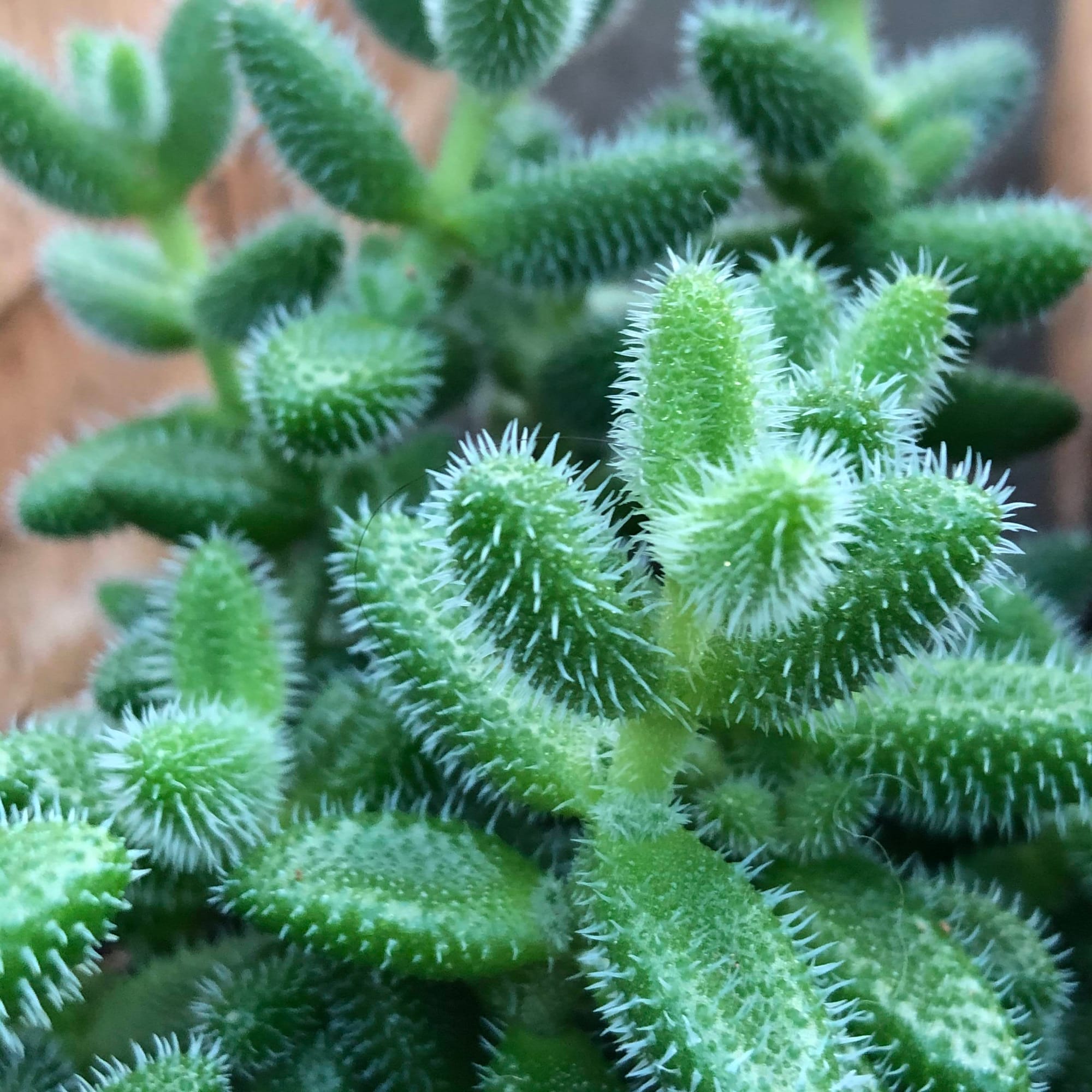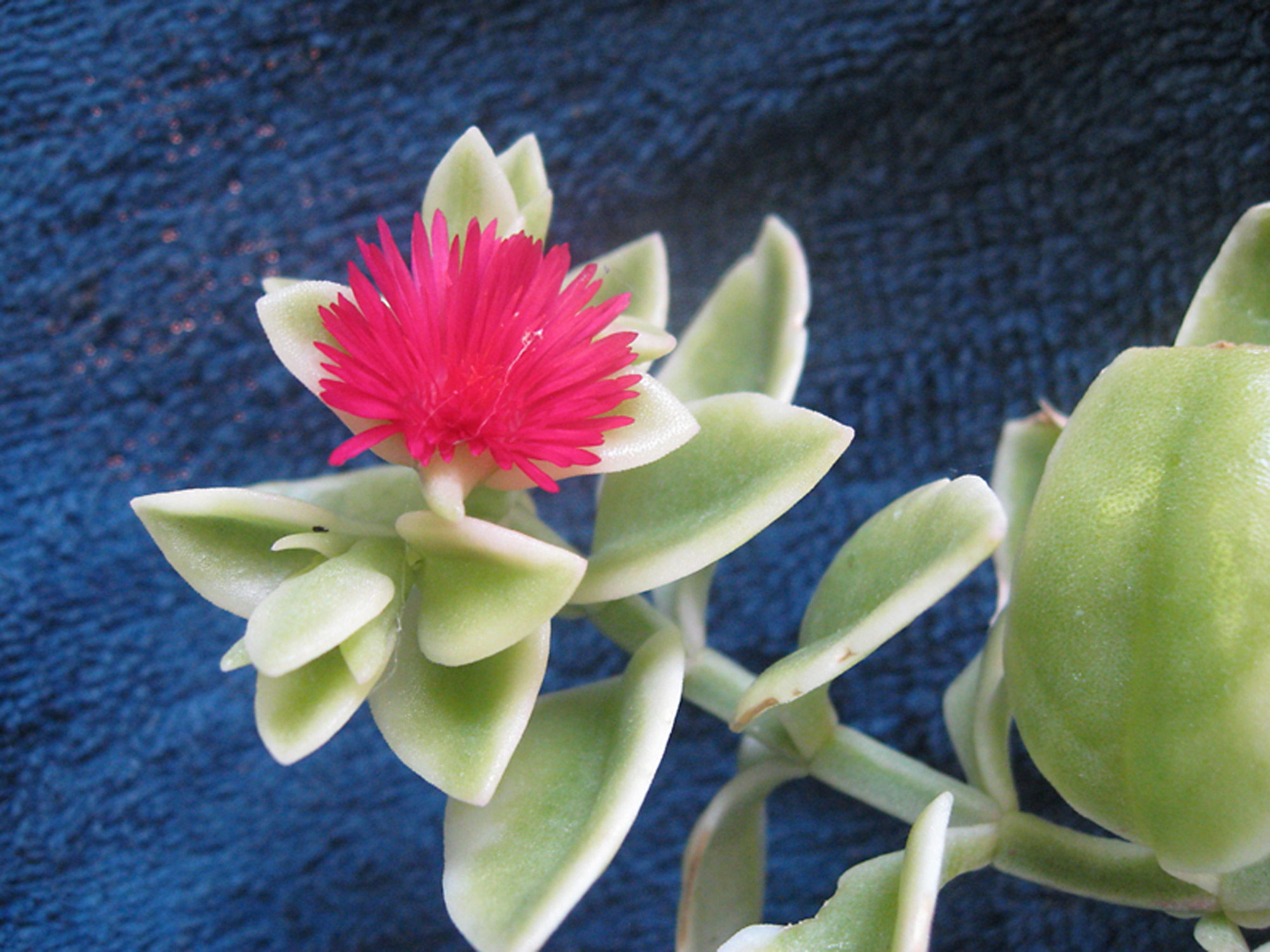
Delosperma echinatum - Pickle Plants
Contents
- Top Tips
- Location, Water, Humidity & Fertilisation
- Common Issues
- Origins, Temperature, Propagation, Repotting & Toxicity
Need the answer to a specific plant query? Book a 1-to-1 video call with Joe Bagley, the website's friendly author to overcome and address your niggling problem! Available on iMessage, WhatsApp, Facebook Messenger & more.
Top Tips & Info
- Care Difficulty - Easy
- Provide a bright location that offers offer a few hours of either morning or evening sun, especially in the autumn and winter. Avoid situating yours in deep shade due to the risk of basal rot.
- Allow the all of the soil to dry out in between hydration - if you're stuck with when to water it, think of the ukhouseplants' phrase of 'Drenches Between Droughts'.
- Fertilise every two or three months using either a 'Cactus' or 'Houseplant' labelled feed.
- Repot every three years during the spring, using a 'Cactus & Succulent' potting mix and the next sized pot.
Location & Light - 🔸🔸🔸
Place your specimen in the brightest location as possible. A few hours of off-peak sunlight will be highly beneficial for the plant, as it’ll significantly reduce the risk of over-watering and root rot. Due to its intolerance to low light, avoid placing one in areas where a newspaper can't be read without the use of artificial light.
If you've recently purchased an indoor Delosperma, chances are it hasn't acclimatised to the potential direct sunlight you'll give it. If you're interested in placing yours in a brighter environment, gradually increase the light levels over a few weeks to prevent the risk of environmental shock or sun-scorch.
Water - 🔸
Allow all of the soil to dry out in between waters, reducing this further to once every few weeks in the autumn and winter. Not only will a reduction of water reinforce the dormancy period, but it'll also counteract the risk of root rot due to the shortened days and cooler nights. Over-watering symptoms include rapidly yellowing leaves, wilting, mushy leaves or stem and plant death. Again, study where it's situated in your home. If it doesn't receive bright or overhead light, a relocation is mandatory to get your specimen back on track! Alternatively, under-watering symptoms include deflated leaves, little to no growth and gradual foliage decline. Be sure to study its environment; a position that offers too much sunlight will dry out the soil far too quickly and will eventually scorch the plant's leaves.
Humidity -
This is not a necessity; however, a quick hose down from time to time will hydrate the leaves and wash away dust or potential pests.
Fertilisation - 🔸
Fertilise every two months during the growing period and every three months in the autumn & winter to replicate its dormancy period. Although a 'Houseplant' fertiliser will still do the job, we'd recommend using a specific 'Cactus' labelled feed as it'll support the vital thirteen nutrients that this species will need to grow.
 A key difference between Delosperma & Sedum is the formation of its inflorescence. Indoor Delosperma tend to develop singular blooms, whereas the latter will develop 'clusters' of more than one flower.
A key difference between Delosperma & Sedum is the formation of its inflorescence. Indoor Delosperma tend to develop singular blooms, whereas the latter will develop 'clusters' of more than one flower.
Common Issues with Delosperma
Root rot is a common issue among specimens sat in too dark environments with prolonged soil moisture. Symptoms include rapidly yellowing leaves, mouldy soil, shrivelled growth and a rotten brown base. Take the plant out of the pot and inspect health below the compost line. If the roots sport a yellow tinge, you're good to go, but those that are brown and mushy must be addressed immediately. More information about addressing root rot can be found on this link.
Failed leaf or vine cuttings are a common issue among amateur gardeners, with damaged wounds or too small vines being the usual culprits. Although Delosperma propagation is relatively easy, people still find it hard to ace. Not only will the size of the vine dictate its success, damaging the leaves or vine can also hurt the chances of it rooting. Scroll down to 'Propagation' for more information regarding this issue!
Too much sunlight will cause a red tinge to the foliage. Although Delosperma is best grown in locations offering around two hours of direct sunlight a day, prolonged periods of intense rays cannot be tolerated. Reduce the amount of sunlight received to just one hour a day, while keeping the growing conditions relatively similar to reduce the effects of environmental shock. Although the new growth will revert to its original green texture, sunburnt leaves will remain scorched for the rest of its functioning life.
Reddened leaves are the product of too much sunlight, most common during the height of summer. A pigmentation called 'Carotenoids' will alter the appearance of the foliage to counteract the harsh effects of the UV rays. Although this isn't a permanent look, and the specimen will still function adequately, it'll grow far better and quicker in a slightly shadier location with only a splash of direct sun. Still providing an hour or so of bright light will lessen the effect of environmental shock and potential death.
Origins
Delosperma consists of around two hundred species that mostly originate around east to Southern Africa. The genus was first described in 1925 by Nicholas Brown, using the Greek words, delos and sperma, to mean 'exposed seed'. Many species within Delosperma also have hygrochastic capsules, which repeatedly open when wet, and close when dry!
 The Distribution of Delosperma.
The Distribution of Delosperma.
Temperature
10° - 26°C (50° - 78°F)
H1b (Hardiness Zone 12) - Can be grown outdoors during the summer in a sheltered location with temperatures above 12℃ (54℉), but is fine to remain indoors, too. If you decide to bring this plant outdoors, don't allow it to endure any direct sunlight as it may result in sun-scorch and dehydration. Regularly keep an eye out for pests, especially when re-introducing it back indoors.
Spread
Up to 60cm in length and 40cm in width. The ultimate height will take between 3 - 5 years to achieve, but can live over a decade or more in the right care.
Pruning
Remove yellow or dying leaves, and plant debris to encourage better-growing conditions. While pruning, always use clean utensils or shears to reduce the chance of bacterial and fungal diseases. Never cut through yellowed tissue as this may cause further damage in the likes of diseases or bacterial infections. Remember to make clean incisions as too-damaged wounds may shock the plant, causing weakened growth and a decline in health.
Propagation
Leaf Cuttings (Easy) - Leaves that are halfway along the vine have the most potential due to its size and maturity. Gently place your fingers between the mother's stem and the leaf's base, pulling it downwards until you hear a snap. Ensure the wound is wholly intact with no damage, as a bruise or tear will result in unsuccessful propagation. Set the leaf ON TOP OF a bed of moist 'Cactus & Succulent' compost for root growth. Not only will this callus the wound (to prevent disease), but it'll also speed up the propagation process considerably. Once there are signs of small roots developing on the node, place it one third into the compost, at a slight angle. Provide a bright setting with temperatures around 18°C (64°F) with the majority of the soil drying out in between waters. New leaves should emerge within a month or two, thus signalling the start of its independent life!
Stem Cuttings (Easy) - Using a clean pair of scissors, cut a 10cm (4 - 5 inches) section off the stem's terminal. Be sure to use a fresh, damage or pest-free piece as unhealthy divisions are more likely to fail. Remove the older half of the leaves, so that the stem's lower portion is bare, to speed the process of root development. Purchase a 'Cactus & Succulent' compost and vertically push the cutting's base into the soil, avoiding the risk of covering the actual foliage with soil. Situate the cutting in a bright, indirect setting with temperatures above 18°C (64°F). As the roots will develop first, remove the bag and treat it as an adult specimen once there are signs of new foliar development.
Flowers
Delosperma may bloom in the summer if its previous dormancy period has been served well. Small white, pink or red flowers will develop at the vines' terminals that can last up to several weeks. The quality of its blooms largely relies on the quality of the dormancy period served in the previous winter.
To replicate its dormancy period:
- Reduce temperatures down to around 12°C (54°F) from late autumn until early spring, with little hydrations or fertilisation.
- Allow all of the soil to dry out for at a fortnight in between irrigations thoroughly, and never apply cold water as this may damage the roots.
- Provide a few hours of off-peak direct sunlight with one fertilisation throughout this period, until the first bud develops at the end of spring.
Repotting
Repot every three years in the spring using a 'Cactus & Succulent' potting mix and the next sized pot with adequate drainage. Delosperma are far better being potbound for several years due to the heightened risk of root rot and repotting-issues (like transplant shock), so only repot if you feel it's wholly necessary - restricted root growth will also increase the chance of blooms, too.
Hydrate the plant 24hrs before tinkering with the roots to prevent the risk of transplant shock. For those situated in a darker location, introduce an extra amount of perlite and grit into the deeper portion of the pot to downplay over-watering risks. Click on this link for a detailed step-by-step guide on transplantation, or via this link to learn about repotting with root rot.
Book a 1-to-1 video call with Joe Bagley if you'd like a personal guide to repotting your houseplant. This will include recommending the right branded-compost and pot size, followed by a live video call whilst you transplant the specimen for step-by-step guidance and answer any further questions!
Pests & Diseases
Keep an eye out for mealybugs, scale, fungus gnats, whitefly, vine weevils & root mealybugs that'll locate themselves in the cubbyholes and undersides of the leaves, with the exception of the latter two in the soil. Common diseases associated with this genus are root rot, leaf-spot disease, botrytis, rust, powdery mildew & southern blight - click here to learn more about these issues.
Toxicity
Not known to be poisonous when consumed by pets and humans. If large quantities are eaten, it may result in vomiting, nausea and a loss of appetite.
Retail Locations
Online Stores.
Book a 1-to-1 Call with Joe Bagley
If you need further advice with your houseplants, book an advice call with ukhouseplants' friendly and expert writer today! This can be done via a video or audio call on most apps, including Facebook, FaceTime & Skype. A ten-minute call costs £5.99 (US$7), or £15.99 for thirty minutes. You can ask multiple questions, including queries on plants, pests, terrariums, repotting advice and anything in between. Please consider supporting this service to keep ukhouseplants thriving!